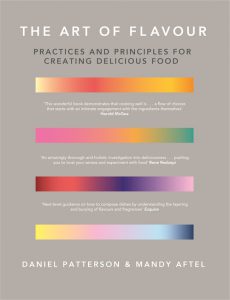The 5pm Dining blog is tickled by The Art of Flavour, a new cookbook written as a collaboration between Daniel Patterson, a chef, and Mandy Aftel, a professional perfumer.
While not household names in the UK, both Patterson and Aftel are well-known in their respective fields in the States.
Patterson has won two Michelin stars for his San Francisco restaurant Coi as well as food awards including prestigious numerous James Beard prizes.
Aftel has been profiled in the New York Times T Magazine and is constantly featured and quoted in other magazines such as Vogue and Vanity Fair.
The Art of Flavour: not your usual cookbook
Subtitled Practices and Principles for Creating Delicious Food, The Art of Flavour is not, however, a recipe book that trades on its authors' fame or profile.
Indeed, The Art of Flavour is different from most other cookbooks in a number of ways.
It is a recipe book - it has more than 60 recipes - but they are not themed around typical cookbook subjects such as comfort food, quick and easy dishes or the cuisines of a specific country. The Art of Flavour: cook smart
The Art of Flavour: cook smart
Instead, it is about Patterson and Aftel's ideas on how to create and blend tastes along with information on the history and science of flavour. It is a book that people will read for pleasure and interest as well as ideas for improving their own cooking.
The recipes are clear and, in general, simple with relatively few ingredients. They are not the sort of thing where you need a professional test kitchen and a staff of ten to make them. They are for home cooking.
The recipes illustrate the authors' theories and concepts about what sort of tastes go together; how they can be enhanced and how they can be used to elevate individual ingredients and harmonise with one another.
For example, a recipe for chicken and aubergine cooked with aromatic spices is followed with this tip:
'Long cooking is a basic method for melding disparate flavours into one, and this recipe can be made with almost infinite variations to arrive at new flavours. Making this the day before and letting it rest in the refrigerator overnight will only improve it.'
Now, your granny knew that soup tastes better the day after you made it. The Art of Flavour digs a bit deeper and explains why and how you can usefully use this technique in other dishes.
Understanding flavours
You could head to the kitchen and cook a dish from each recipe. Or you could use each recipe as a building block to understanding how flavour works. From there, you can twist the recipe in the book; use it create your own dishes or apply the principles learned to some of your other favourite dishes.
Put another way, most cookbooks do the culinary equivalent of telling you that the circumference of a circle can be calculated by multiplying its diameter by pi.
The Art of Flavour helps you understand why C = πd.
Right at this point, your blogger feels in grave danger of ending up in Pseud's Corner. Time to stop havering and let one of the recipes do the talking.
Steamed halibut with bok choy and soy- lemon sauce
Serves 4
This recipe works with any white- fleshed fish. Steaming preserves its delicate texture and flavour and keeps it moist and tender. Because there are no additional flavours added from a browning process, the fish must be very fresh.
Ingredients
500g fillets of halibut or other white- fleshed fish, 1 to 2 centimetres thick
Salt
250g bok choy, separated into leaves
2 tbsp dark soy sauce
2 tbsp freshly squeezed lemon juice
½ tsp chilli flakes
2 tbsp vegetable oil
Put a bamboo or other steamer in a pan with at least 2.5 centimetres of simmering water below.
Season the fish with salt, place it on the steamer, and cover. After two minutes add the bok choy and cook for two minutes more, or until the fish is done.
While the fish is cooking, combine the remaining ingredients. When the fish is cooked and the bok choy is tender, divide them among serving plates. Then drizzle the sauce over them.
Tip: In this recipe the vegetable oil creates mouth feel and connects the soy and lemon without imposing any flavours of its own. Sometimes you want a fat to bring flavour, and other times, as here, you want it simply to carry the flavours around it.
Published by Robinson, The Art of Flavour is released in hardback on 5th April 2018, £20.